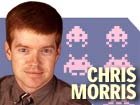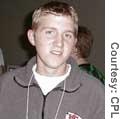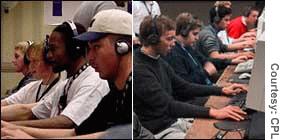|
Kill an alien, win a car
|
 |
December 27, 2001: 9:42 a.m. ET
Professional computer gamers use hand-eye coordination for fun and profit.
By Staff Writer Chris Morris
|
NEW YORK (CNNmoney) - On a Sunday afternoon in early December, 20-year-old Johnathan Wendell sat down in front of a PC and started blasting away in an intense game of "Aliens vs Predator 2", a frenetic shoot-'em-up title that's fast becoming a favorite of action gamers. By the time he finished, Wendell was the new owner of a fully customized 2002 Ford Focus ZX3 (valued at roughly $35,000).
Wendell, better known as "Fatality" to his gaming buddies, is one of a select few professional gamers in the U.S. He plays computer games for up to 12 hours per day. He holds no traditional job. But in his two years as a pro he has won more than $150,000 in cash and prizes. Not a bad way to earn a living.
The cash comes from competitions such as those sponsored by the Cyberathlete Professional League, a four-year-old organization that's aiming to change the world's thinking about computer gamers.
The CPL is the brainchild of Angel Munoz, a former investment banker in Dallas. A client who was seriously into computer gaming introduced him to the industry. A few years later, the two teamed up to launch the league.
| |

|
|
Johnathan 'Fatality' Wendell | |
The CPL holds mammoth tournaments pitting teams of gamers against each other as well as single-player competitions. The most recent event, held in Dallas from Dec. 5-9, awarded $150,000 in cash and an additional $100,000 in merchandise, including the souped-up Ford that Fatality drove home.
The electricity consumed during this four-day "world championship" would have powered a neighborhood of 77 people for a month, according to Munoz. Total costs topped $500,000, he estimates.
To offset this, the company relies on sponsorships by such big name companies as Intel (INTC: down $0.39 to $31.85, Research, Estimates) and Altec Lansing (though it won't say how much those companies contribute). Supplemental funding comes from Munoz's friends in the investment banking world. And players pay $50 to compete, while spectators shell out $5. Munoz eventually hopes to merchandise the CPL name in various European countries to supplement income. He's also negotiating for a broadcasting deal with a "large cable operator" he refuses to identify.
A likely candidate, though, is G4, a new television network that's being launched in April 2002. With a guaranteed subscriber base of 7 million from Comcast Cable and Insight Communications, the channel's management team includes Charles Hirshhorn, former president of Walt Disney television and television animation.

|
|
|
Teams of players try to win this year's CPL World Championship. | |
Meanwhile, computer gaming continues to try to legitimize itself in the eyes of the public and the media. Mainstream media outlets, including our corporate cousins at CNN Headline News, have interviewed Munoz about the tournament. ESPN even sent a crew out to film highlights of the most recent event.
Munoz said 1,500 people attended this year's event, though those in attendance estimated the number to be significantly lower. The people in the spectator seats and on the gaming floor were the hardest of the hard core gaming crowd - generally the same folks you'd expect to see at a science fiction/fantasy convention ("stinky boy fest" is how one attendee described the scene), only this crew is power-slamming "Bawls Guarana," a caffeine-dense energy drink.
Not exactly how you pictured the professional athlete of the future, huh?
Click here to send email to Chris Morris 
|
|
|
|
|
|

|

